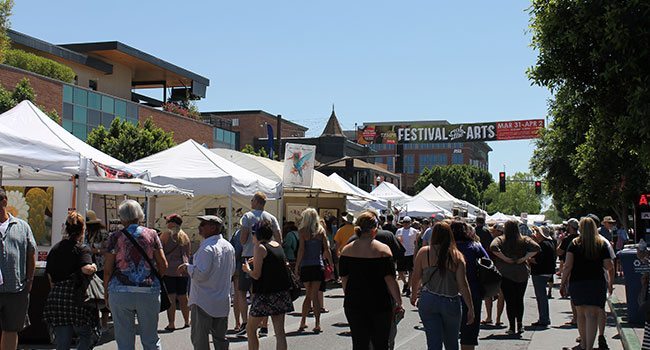Artists and craftsmen from around the country came together once again this past weekend for the 40th Annual Tempe Festival of the Arts, showing off talents in every visual medium from painting to glass blowing.
The festival’s spring and fall events attracts hundreds of thousands of visitors of all ages, providing a variety of activities and food options for guests, as well as nearly 400 artists’ work on display and for sale all weekend. The 40th iteration of the festival was held on March 31 to April 2.
Entrepreneurial artists from around the country are picked from 17 different visual arts categories to contribute to the festival. Many of them travel, visit and participate in art festivals throughout the country. For these artists, art shows like the Tempe Festival of the Arts are the perfect opportunity to sell their work, gain exposure and build relationships with their customers.
The Tempe Festival of the Arts has a long history in the city, and throughout its 40 appearances on Mill Avenue it has gained strong community support, according to event coordinator and executive director of Downtown Tempe Authority Kate Borders. She said the idea for the festival stemmed from a need to bring in more business and tourists to the Tempe area.
“It was a question of ‘how do we draw people to our downtown area and also benefit the merchants?’” Borders said.
She said many of the businesses on Mill Avenue do benefit from the festival and the foot traffic it brings.

Employee Rebecca Brantley at Lotions and Potions, a shop on Mill Avenue, said the store usually sees a positive impact from the art festival.
“Sales obviously go up every time you have this many people all in one place,” Brantley said. “They have easy access to lots of different shops.”
The city has seen a growth in housing complexes over the last few years, but this has not slowed the Tempe Festival of the Arts. Borders said typically it just means more foot traffic for the show.
“Typically people want to live downtown because they are drawn to areas that are vibrant,” she said. “Generally speaking our attendance is up.”
Borders said the event receives more applications for attendance from artists and vendors every year, but keep it limited to about 350 booths to prevent visitors from becoming overwhelmed.
“The artists that come, this is how they make their living,” she said. “Historically we draw big crowds and they have good sales for the weekend.”
New experiences and attractions were brought to the 40th Annual Tempe Festival of the Arts this year. The wine tasting event returned to the scene, with nine Arizona wineries and tasting tickets available for guests to sample or buy the wines. Three stages featuring live entertainment were also running all three days of the festival, an increase from the one or two that had been set up in the past, according to Borders.

She said the Kid’s Block, which made its debut at the fall event last December, was a particular area of focus for the Tempe festival this year. Fifteen community partners hosted activities for kids throughout the weekend, including an opportunity for the young visitors to get creative with sidewalk chalk on the Chalk-A-Lot Street.
Richard Curtner, a returning artist from California, said he enjoys selling his work at art festivals like the Tempe Festival of the Arts because of the interaction with his customers.
“I like the immediate feedback and getting the honest comments about what they like and don’t like,” Curtner said. “It gives me motivation to keep creating for sure.”
Curtner said he has developed good friendships with customers and other artists over the years at the Tempe Festival of the Arts.
Other vendors, like Peter Bingham, find festivals to be the best avenue to sell products. Bingham has been selling soy wax candles at the Tempe art festival for 12 years, and participates in 40 different art and craft shows every year.
“For me, it’s really important to be out doing the festivals,” he said. “That way I can promote my brand, and the customers will actually see what they’re getting.”

Bingham sells his candles online but has more success at festivals because that’s where his customers look for him and his products specifically.
“People need to smell the candles to be able to buy them,” he said. “If you go online you can see a hundred people making soy candles, but you can’t smell them so you don’t know the difference between the good and the bad ones.”
A face-to-face experience is what many vendors and people visiting the festival look forward to the most.
Ann Kennedy and her husband Michael returned to the festival this year to sell their wood works. Their business, Kiwi Woodkraft, benefits from the variety of visitors at art festivals.
“You can reach a wider scope of people,” Kennedy said. “You meet people who are more interested in small businesses and handcrafted, fine art instead of highly produced things that you can buy at a chain store.”
The Tempe Festival of the Arts provides a unique experience and a greater platform from which to sell their work, according to Kennedy.
“We particularly enjoy the Tempe arts festival because of the amount of people and how the event is advertised,” she said. “The quantity of artists represented and the range of art is unique; I know the Tempe festival really tries not to saturate any one medium, which we appreciate as artists.”
Erika Besthoff agreed, saying the Tempe Festival of the Arts has been one of the most successful markets for her jewelry business. Besthoff and her sister make bracelets and rings out of coins from different countries, which they inherited from their grandfather’s coin collection.
“It’s definitely been one of the best markets we’ve ever done because of foot traffic,” Besthoff said. “I think that we’ve had some less successful markets because they either weren’t marketed well enough or they just didn’t have the foot traffic.”
The Besthoff sisters have been selling their jewelry for about a year and a half, and they hope to return to the Tempe festival in the fall.
“Being able to support other small business owners has been another great part about the festival,” Besthoff said.
Big crowds and customer interaction are two of the biggest draws for vendors to sell their work at art festivals, but the Tempe Festival of the Arts provides another key appeal for its artists; exposure.
Ken Reif, a painter from Chicago, travels to Arizona every March to take part in art shows throughout the state. He said the biggest benefit to selling his artwork the festival is the exposure he gets.
“There’s no other way you can show your work to so many people. Thousands of people see your work in one day,” Reif said. “Tempe’s festival has the most people and the most diverse crowd.”
The festival certainly was able to provide exposure for artists like Reif, as 225,000 visitors went to the Tempe Arts Festival through the course of the weekend.




